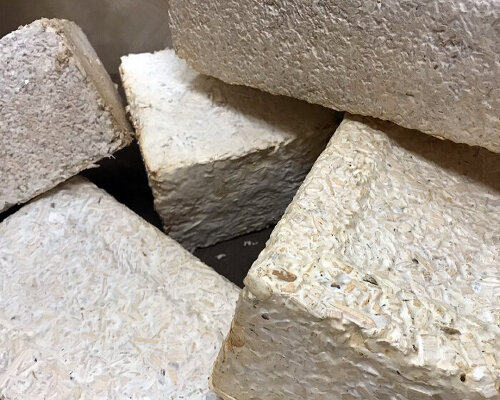Space habitats made of mycelium by NASA
NASA advances its research to grow habitats in space for explorers and researchers using bricks made from mycelium. Called Mycotecture Off Planet, a team of researchers at NASA’s Ames Research Center in California, led by Lynn Rothschild, develops the project, which has recently received funding from NASA’s Innovative Advanced Concepts (NIAC) program to continue their work.
The NASA team’s goal is to create mycelium-made habitats out of Earth that can be grown rather than delivered fully built to save weight and space on rockets and make it easier to set up safe shelters once astronauts arrive on the Moon or Mars. Instead of launching large buildings, astronauts would take a lightweight, flat-packed structure made with dormant fungal materials, and once they land, they would add water to the structure.
all images courtesy of NASA
Biomaterial project enters the third and final phase
By adding the liquid, the root-like network of mycelium would ‘wake up,’ and it would begin to grow and shape itself around the structure. Over time, the fungi would fill out the form and harden into a safe, livable shelter. The whole system would be contained, meaning there’s no risk of the fungi spreading uncontrollably or harming the surrounding environments. This project has already made a lot of progress in earlier phases of development, with the team having created several types of materials made from fungi, built sample structures, and tested how the materials perform in simulated space environments. They’ve even added features like radiation shielding to make the habitats safer for humans and have also drawn up detailed plans for what a fungal moon habitat could look like.
Aside from using the mycelium habitats in space, NASA’s project could be useful on Earth since fungi could help clean water through filtration or extract useful minerals from wastewater and support efforts to fight climate change and pollution. The team has now reached Phase III, which is the final and most advanced phase in the NIAC program, and from here, they expect to focus on improving the material’s strength, durability, and safety. They also plan to begin preparing the technology for future tests in low Earth orbit, the region just outside Earth’s atmosphere where satellites and the International Space Station orbit, and if all goes well, the fungi-based habitat system could be used on commercial space stations, future Moon bases, and eventually even on Mars.
stool created by a NASA-funded project using the same fungal mycelia that create bricks on Earth
view of a stool constructed out of mycelia after two weeks of growth
NASA advances its research to grow habitats in space using bricks made from mycelium
project info:
name: Mycotecture Off Planet
agency: NASA | @nasa
division: Ames Research Center | @nasaames
program: NASA’s Innovative Advanced Concepts (NIAC)
The post NASA to grow habitats in space for explorers using bricks made from mycelium appeared first on designboom | architecture & design magazine.

